This is the ultimate SEO checklist for 2022. If you are looking for a comprehensive checklist to follow to optimize your website for Google in 2022, then you just found the right place.
Our SEO checklist is complete and covers all areas of SEO including SEO basics, technical SEO, on-page SEO, keyword research, Off-Page SEO, Local SEO, and mobile SEO.
How to use this SEO Checklist?
The best way is to download the list, print it, and start working through the items one-by-one.
When you do this the first time don’t try and fix things, go through the whole list first, and create your own SEO checklist.
- SEO Basics Checklist
- Technical SEO Checklist
- On-Page SEO Checklist
- Keyword Research Checklist
- Off-Page SEO Checklist
- Local SEO Checklist
- Mobile SEO Checklist
For some of the list items, you will have to do some further reading in order to get it right but as long as you are in control of your list, sooner or later you will finish all tasks.
Don’t forget that when it comes to SEO, sometimes it’s a lot of small things together that can make a difference in your Google rankings.
Download SEO Checklist as a PDF

The Complete SEO Checklist for 2022
- Understand basic SEO concepts and key terms
- Add and verify your website with Google Search Console
- Add and verify your website with Bing Webmaster tools
- Setup Google Analytics and learn how to use basic SEO reports
- Check for Google penalties
- Check your permalink structure and make your URLs SEO Friendly
- Install SSL and make sure that your website is HTTPS
- Check the ‘Coverage Report’ in the Google search console for errors
- Check and optimize your robots.txt file
- Check WordPress visibility settings
- Check your comment settings and make sure that all comment links are ‘nofollow’
- Optimize your menu and site structure
- Optimize your XML sitemap and submit to Search engines
- Check for sitemap errors in Google Search Console
- Add structured data markup data to your homepage
- Test your structured data markup implementation
- Enable breadcrumb menus on all your posts and pages
- Check that your schema implementation for breadcrumbs is correct
- Check that all your pages define a canonical URL
- Implement hreflang if your website is available in more than one language
- Check and optimize your 404 Page
- Check and improve the loading speed of your website
- Use Lazy Loading for images and videos
- Optimize your logo and favicon
- Optimize your page titles (including the homepage)
- Optimize your meta descriptions (including the homepage)
- Check for your brand name on Google
- Optimize your website for Google sitelinks
- Optimize your posts for Google sitelinks
- Optimize your posts for Google featured snippets using lists
- Check and optimize the H1 tag for all pages (including the homepage)
- Check and optimize your page headings
- Make sure that your target keyword is included in your opening paragraph
- Add text content to accompany your non-text content
- Optimize your content for E-A-T
- Beautify your content (formatting and styling) and make it easy to read
- Optimize your images
- Create a dedicated image sitemap and submit it to Google
- Optimize your videos and other multimedia elements (with proper schemas)
- Create a dedicated Video sitemap and submit it to Google
- Optimize titles/description/content of your category pages
- Check your internal linking strategy
- Give credit to other high-quality websites
- Understand what are SEO Keywords
- Understand what are long-tail keywords
- Learn how to perform keyword research
- Learn how to use the outcome of keyword research to optimize your content
- Learn what is link building and why it’s important
- Learn the basic link building concepts
- Get links from high authority websites (11 methods)
- Review your link profile to identify and remove bad links
- Optimize your logo for local SEO
- Add NAP information (Name, Address, Phone Number) on ALL your pages
- Make sure that NAP information is consistent across all channels
- Add a Google map to the contact information page
- Register your company with Google My Business
- Use Schema to give more information about your local business to Google
- Register your website with relevant directories (examples included
- Encourage and reply to every single review on all platforms
- Seek mentions (links) from the local press)
- Run the Google mobile-friendly test
- Check your mobile speed using different tools
- Test your mobile website on different resolutions
- Check popup usage on mobile
- Check that your CTA on mobile are visible and easy to access
Note: If you need more information for any of the list items, check out the Complete SEO Course – a comprehensive course that covers ALL areas of SEO and it is literally the only SEO Course you’ll ever need to read.
SEO Basics Checklist
To take advantage of this checklist and use it effectively to improve your SEO, you need to understand the different components that make up search engine optimization or SEO as it is widely known.
Here is your SEO basics checklist:
1. Understand basic SEO concepts and key terms
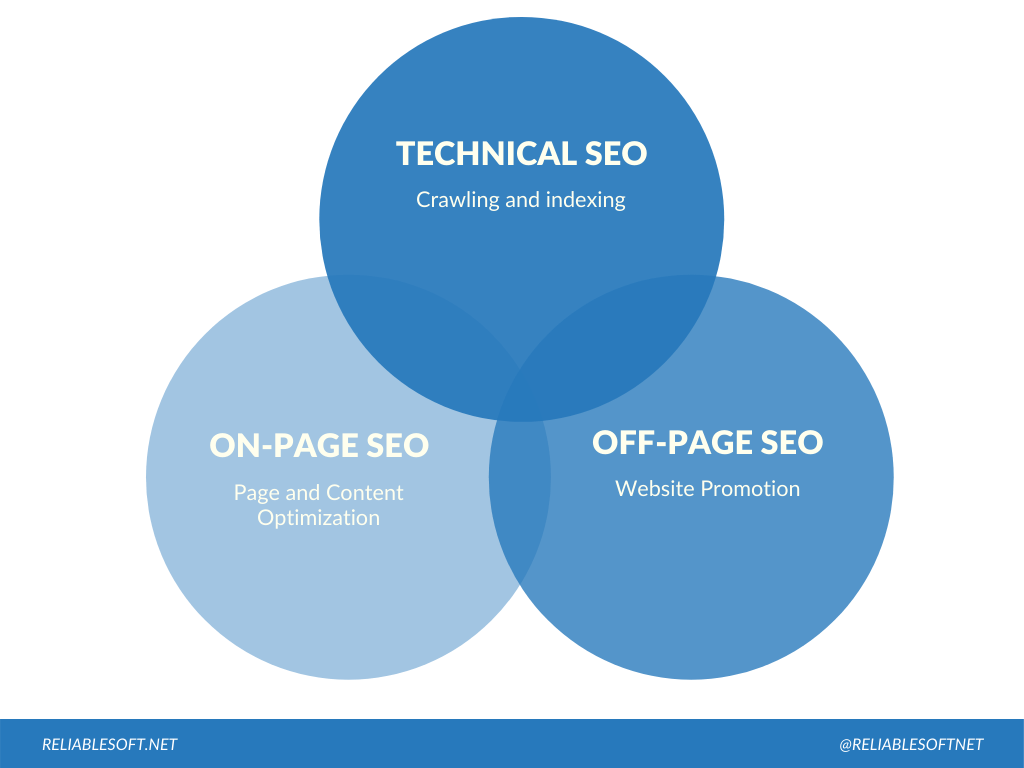
What is SEO?
SEO is a process that has a set of rules you can apply to your website so that search engines can access, crawl, and index your content without problems.
Your overall goal with SEO is to create better websites both in terms of content and usability that will keep both users and search engines happy.
If you have read my previous post on how search engines work, you know that search engines are governed by complex algorithms that use a number of parameters before making a decision as to which websites to show at the top of the search results.
To be able to control the whole SEO process and give algorithms what they want, the various SEO rules are grouped into three main categories and thus how other terms like technical SEO, on-page SEO, off-page SEO were born.
2. Add and verify your website with Google Search Console

Google search console is a free service provided by Google which gives webmasters access to a number of tools and reports for optimizing their websites on Google search.
You can use the Google search console to find out what Google knows about your website, analyze your Google rankings, identify and fix errors related to crawling and indexing and inform Google about changes made to your website.
GSC is the most important tool to use to optimize your website’s SEO.
To get started with the Google search console you first need to create an account and then add and verify your web properties.
3. Add and verify your website with Bing Webmaster tools
Bing although it is not as popular as Google, is the second most used search engine and is worth considering.
Bing has a set of tools you can use to optimize your website’s appearance on Bing Search. These are called Bing Webmaster tools and have similar functionality to GSC.
4. Setup Google Analytics and learn how to use basic SEO reports
To be able to monitor your SEO performance you need the help of analytics and reporting tools and Google analytics is the best tool to use (and it’s free).
The first step is to install the Google Analytics code on your website and familiarize yourself with basic SEO reports.
5. Check for Google penalties
One of the basic SEO checks you need to make from the beginning is to ensure that your website is not under a Google penalty.
Google has different penalties (manual and algorithmic) that are imposed as a form of ‘punishment’ to websites that violate their Guidelines.
If your website is hit by a Google penalty, you may have to follow a different route to recover from the penalty first (if possible) and then continue with the SEO checklist.
Technical SEO Checklist
Your goal with technical SEO is to help search engines find, access, crawl, interpret, and index your website without any problems.
It is called “technical” because it has nothing to do with the actual content of the website or with website promotion (more on this later).
Here is your technical SEO checklist:
6. Check your permalink structure and make your URLs SEO Friendly
A permalink is the URL of a webpage. It is called permalink because it is not expected to change throughout the lifetime of the page.
For SEO purposes, you need to check and make sure that ALL your website pages have SEO friendly URLs.
SEO friendly URLs have the following characteristics:
- They are short and descriptive
- They include keywords
- They use hyphens (-) to separate the words
7. Install SSL and make sure that your website is HTTPS
Having an SSL installed on your website is one of the known ranking factors.
An SSL ensures that any information shared between your website and server is secured.
If you haven’t migrated your website to HTTPS yet, then this is a top priority item on your to-do list.
Adding an SSL to your website is not enough for SEO purposes, you need to make sure that you do it correctly to avoid losing your current rankings.
8. Check the ‘Coverage Report’ in the Google Search Console for errors
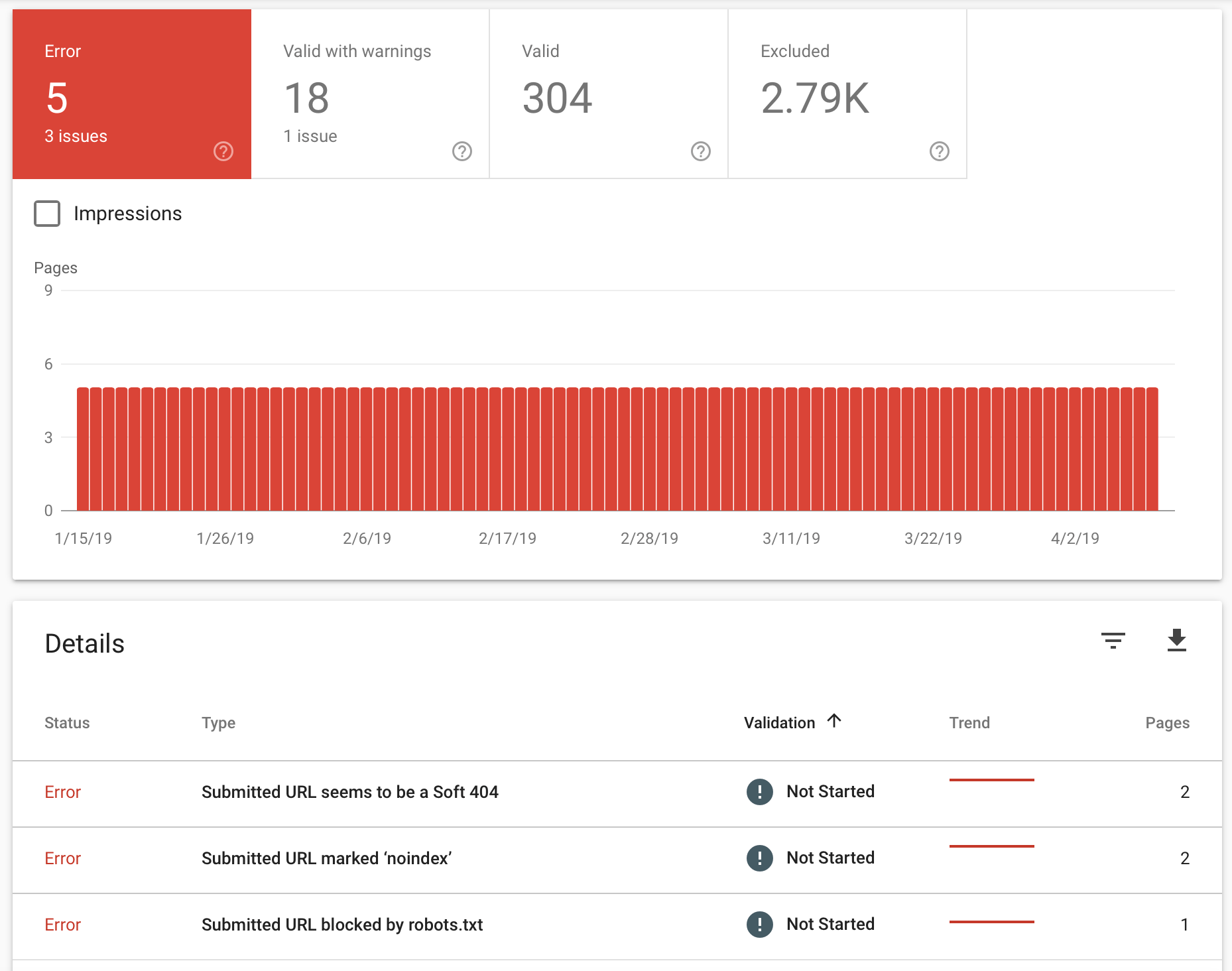
If there are any problems during the crawling and indexing phase then this is very bad for your SEO.
It can cause huge issues with your rankings so one of the checks you need to make on a regular basis is to visit the Coverage report in the Google search console and check for errors.
9. Check and optimize your robots.txt file
Robots.txt is a file that resides in the root folder of your site and gives instructions to search engines as to which pages of your site they can crawl and index.
A misconfiguration in the robots.txt file can cause big errors or even de-indexing of your website from search engine results.
10. Check WordPress visibility settings
If you are using WordPress as your CMS then besides checking the robots.txt file, you also need to check the visibility setting in WordPress and make sure that you are not accidentally blocking search engines from accessing your content.
The setting is found under SETTINGS / READING

11. Check your comment settings and make sure that all comment links are ‘nofollow’
Another check to make is to ensure that any links within your comments section have the nofollow attribute attached.
Comments are good for SEO and should be enabled on your blog but to avoid getting a Google penalty for ‘unnatural links’, all outgoing links need to be nofollow.
A nofollow link instructs search engines not to pass any PageRank (or link juice) to the target website.
The easiest way to check is to use the INSPECT option of Google developers’ tools.
12. Optimize your menu and site structure
If you want to be a true SEO expert, while auditing your website, you should not forget about optimizing your site structure.
This is a mistake I see all the time when performing an SEO Audit.
A good site structure is no more than 3 levels deep and it allows for any website link to be accessed from the homepage in 3 clicks or less.
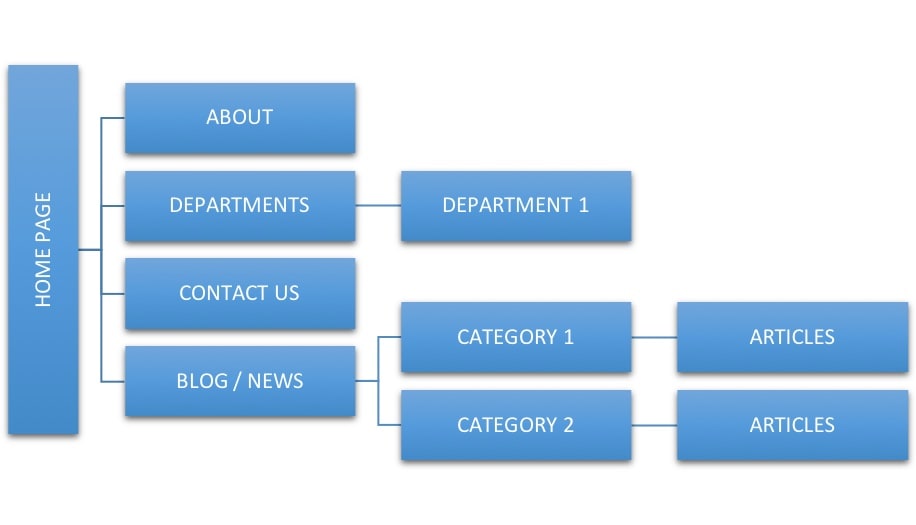
The website menu should accurately reflect the website structure.
If this is not the case with your website, then revising your site structure can help you improve your SEO.
13. Optimize your XML sitemap and submit it to Search engines
An XML sitemap is a file that lists all the pages of your site that search engines need to know about.
You need to check that your XML sitemap is properly optimized and valid and then submit your sitemap to Google and Bing.
14. Check for sitemap errors in Google Search Console
Submitting your sitemap to Google is not the end of the story. You need to regularly check the Google search console for sitemap errors.
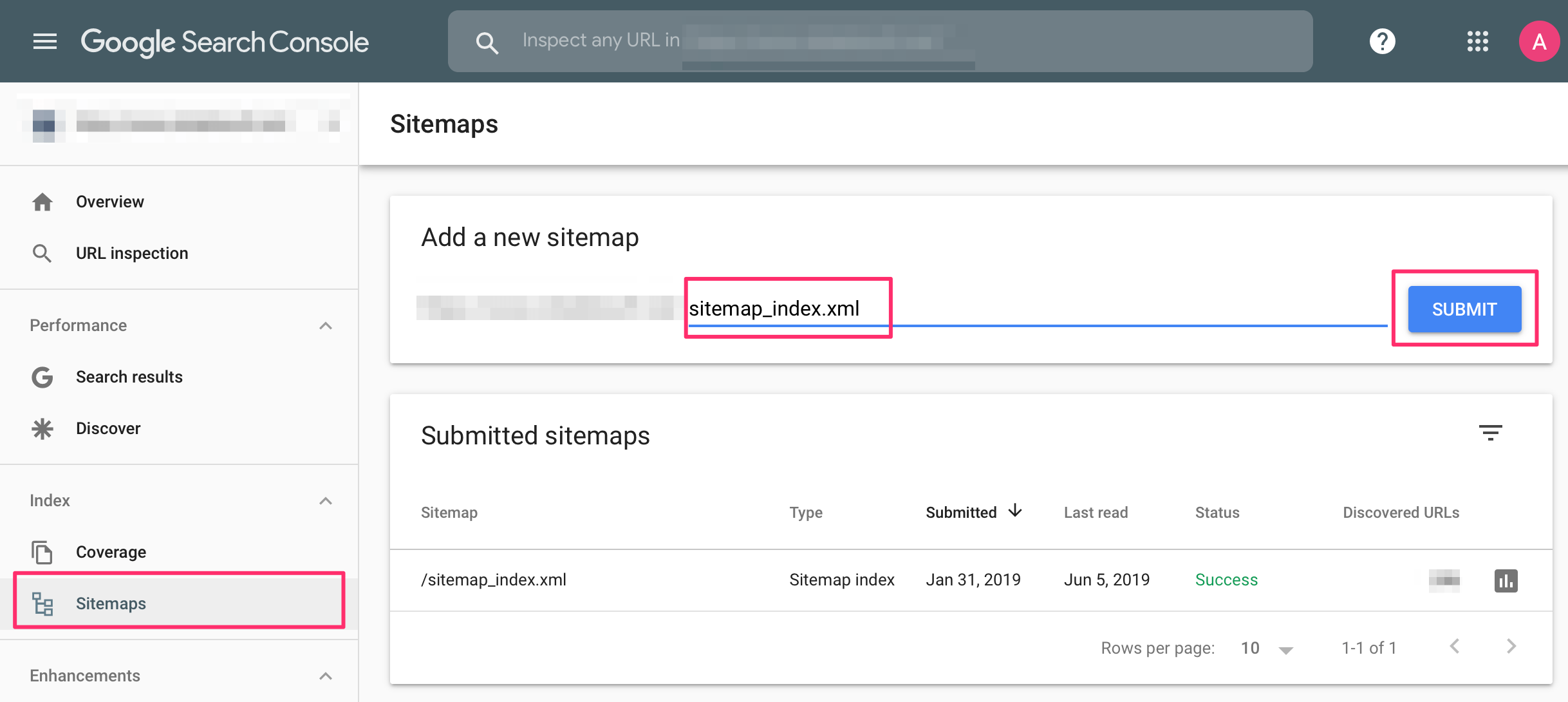
15. Add structured data markup data to your homepage
Schemas and structured data are nowadays very important for SEO.
They can dramatically help you enhance your website’s appearance in Google search results, they are good for local SEO and for Voice SEO.
Many people forget to add the necessary structured data to their homepage and this is a big mistake.
Your homepage is one of the most important pages of your site for many reasons and when it comes to SEO, it should be treated like the rest of the pages.
When it comes to structured data for the homepage, you need to ensure that you define the following schemas:
- Organization (if you are an online business)
- Local Business (if you have a physical presence i.e. a shop)
- Person (if you are running a personal blog).
16. Test your structured data markup implementation
Schema definitions sometimes change so it’s a good practice to check your schema implementation regularly using the rich results testing tool.
You can use the tool to check the structured data you added to the homepage and the rest of your pages.
Keeping your schema info up-to-date and valid is very important.
17. Enable breadcrumb menus on all your posts and pages

A breadcrumb menu is a small menu usually located at the top of a page, used as a navigational aid. It shows the path to go from the current page back to the homepage.
Breadcrumb menus are good for the user experience and thus they are also good for SEO.
Google loves breadcrumbs and they recommend using them on your site.
18. Check that your schema implementation for breadcrumbs is correct
One of the advantages of using breadcrumb menus is that they enhance the presentation of your search snippets in mobile search results.
Google is sometimes using the breadcrumb name instead of the URL in the search snippet so you need to make sure that the relevant structured data is added for your breadcrumbs.
If you are using the Yoast SEO plugin for breadcrumbs, it automatically adds the correct schema and structured data code.
19. Check that all your pages define a canonical URL
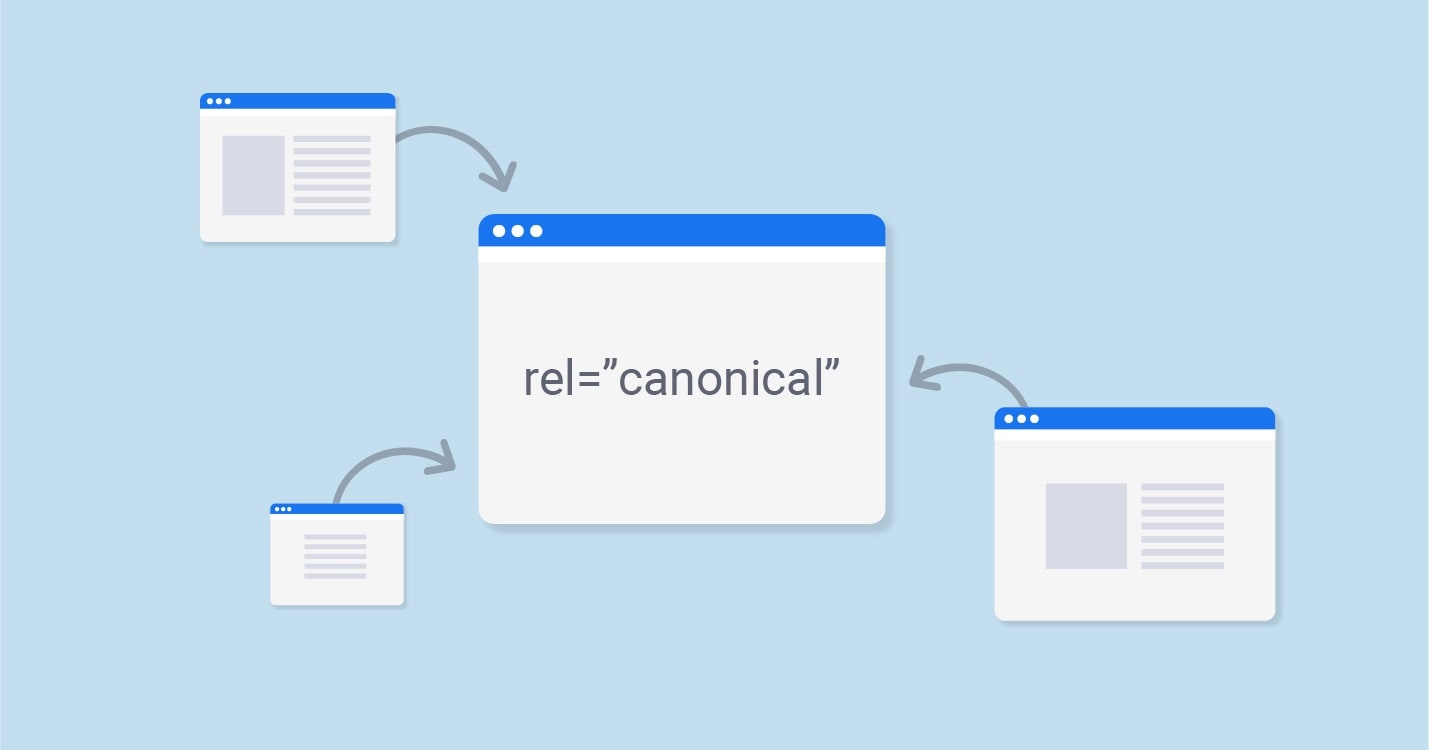
Canonicalization is an advanced SEO concept but something that is extremely important to get right.
Canonical URLs can help you solve duplicate content issues, protect your content when other websites use your content (with or without your concern) and it’s the only way to specify your preferred domain to Google.
To learn more about canonical URLs and how to use them correctly, read these guides:
20. Implement hreflang if your website is available in more than one language
If your website’s content is available in more than one language, you need to use hreflang tags to tell Google about the localized versions of your page.
Failing to do so can create issues for your indexing because Google might get confused if the same page is available in more than one language.
They usually get it right but with the use of hreflang you minimize the possibility of any issues.
Check this guide for more information on how to SEO your Multilanguage website.
21. Check and optimize your 404 Page
The 404 Page is shown when a page is not found on your site. This can be because users mistyped a URL, a page was deleted from your site and is no longer available.
For the best user experience, you need to ensure that your 404 page is meaningful and gives alternative options to users to find what they are looking for.
This is how my 404 page looks like:
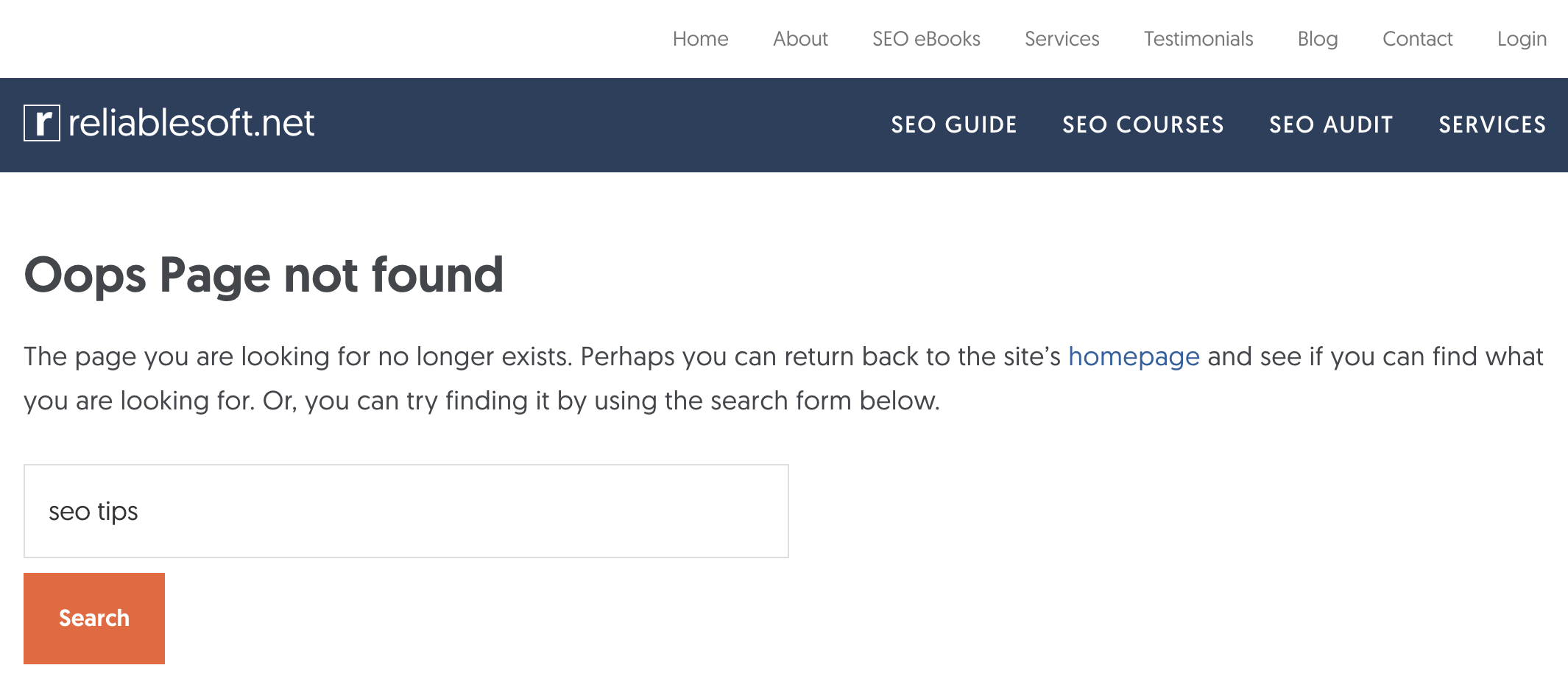
22. Check and improve the loading speed of your website
As part of a technical SEO review, you need to check and improve your website loading speed as much as possible.
Loading speed is a known Google ranking factor and a very important user experience factor.

Slow websites lose money and customers for every second delay.
23. Use Lazy Loading for images and videos
One practical way to improve the loading speed of your site, especially on mobile is to use Lazy loading for images and videos.
Lazy loading is a mechanism that loads images or videos only when they are in the user’s viewport.
Lazy loading can be implemented very easily. If you’re on WordPress you can either use WP-ROCKET (this is the plugin I’m using on this site) or the Native Lazy Load plugin (by Google), to activate this feature on your website.
24. Optimize your website’s logo and favicon
One last thing to review before proceeding to the rest of the items in this SEO checklist is to optimize your website’s logo and favicon
Optimizing means:
Make sure that your logo is an image and not text – Google may decide to show your logo in the search results and in order to do so it has to be an image.
Give your logo the correct name – Do not just use the word logo but use your website name + logo. For example, reliablesoft-logo.png
Add ALT text with your logo – Keep the alt text simple i.e. “reliablesoft logo”
When it comes to the use of a favicon, make sure that you specify a custom favicon for your site that is square in size.
Google is testing showing the favicons in the search results so you need to make sure that your website is represented properly.
On-Page SEO Checklist
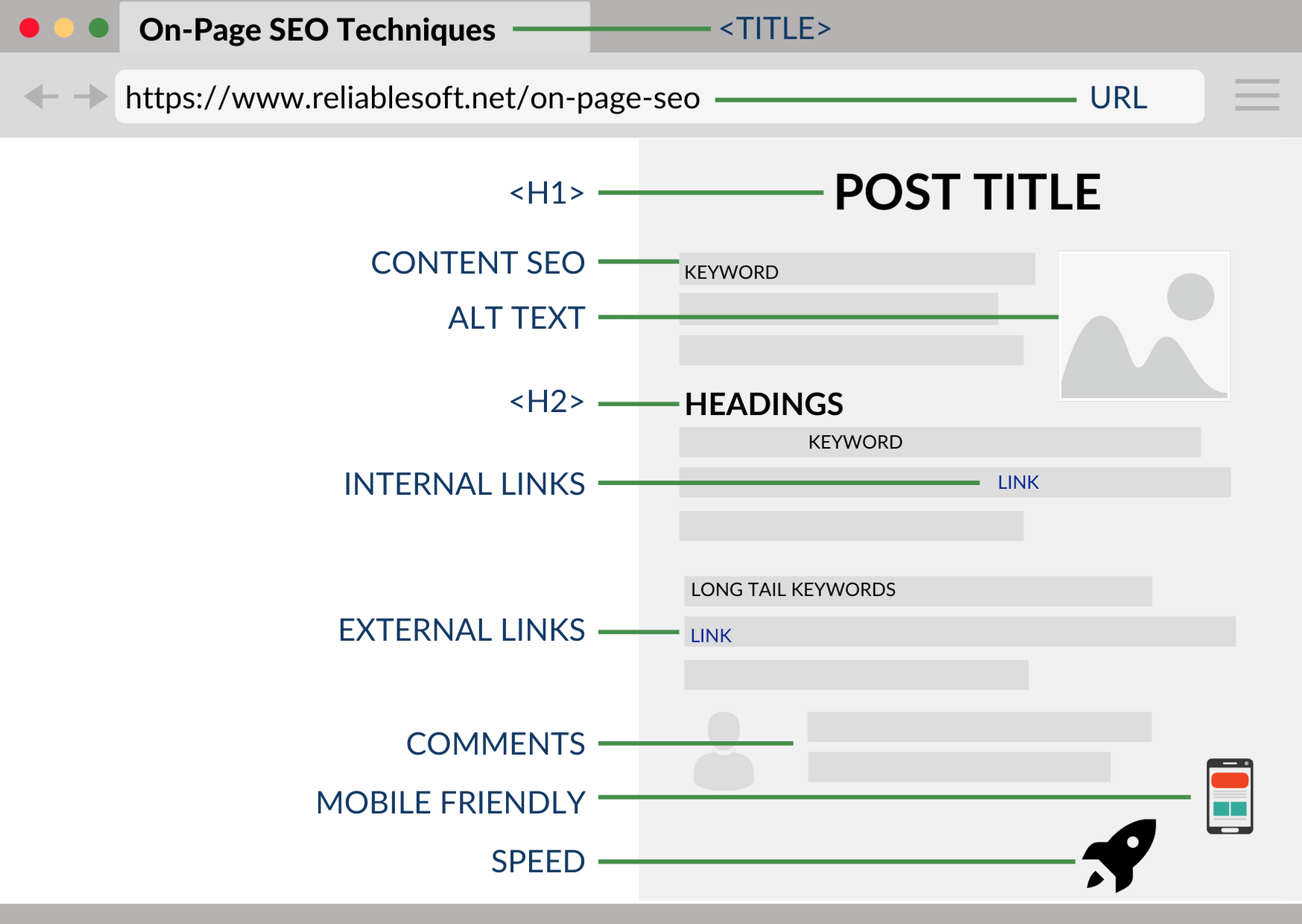
On-Page SEO is all about the content of your page and it has two major goals.
To help you create content that satisfies the user intent and give you guidelines on how to create SEO friendly content that is easily understood by search engines.
Here is your on-page SEO checklist:
25. Optimize your page titles (including the homepage)
Page title optimization is the most important SEO factor. In your title, you should include your target keywords as this helps both search engines and users get an idea of what the page content is all about.
Besides using keywords in the title, you should also follow these best practices:
- Each and every page of your website should have a unique title tag
- A page title should accurately describe the page content
- Titles should be brief and informative (typically less than 60 characters)
When optimizing your titles, don’t forget about your homepage!
26. Optimize your meta descriptions (including the homepage)
Meta descriptions are shown in the search results and it’s a great opportunity to ‘advertise’ your page to users.
Good meta descriptions can increase your CTR (click-through rate) and get you more search engine traffic by utilizing your existing content and rankings.
27. Check for your brand name on Google
A check that you need to make (and not many people do), is to search for your brand name on Google and review the results.
You need to ensure that nothing bad (like a negative review), shows up for your brand name because this can have a negative impact on your reputation but also on your SEO.
28. Optimize your website for Google sitelinks
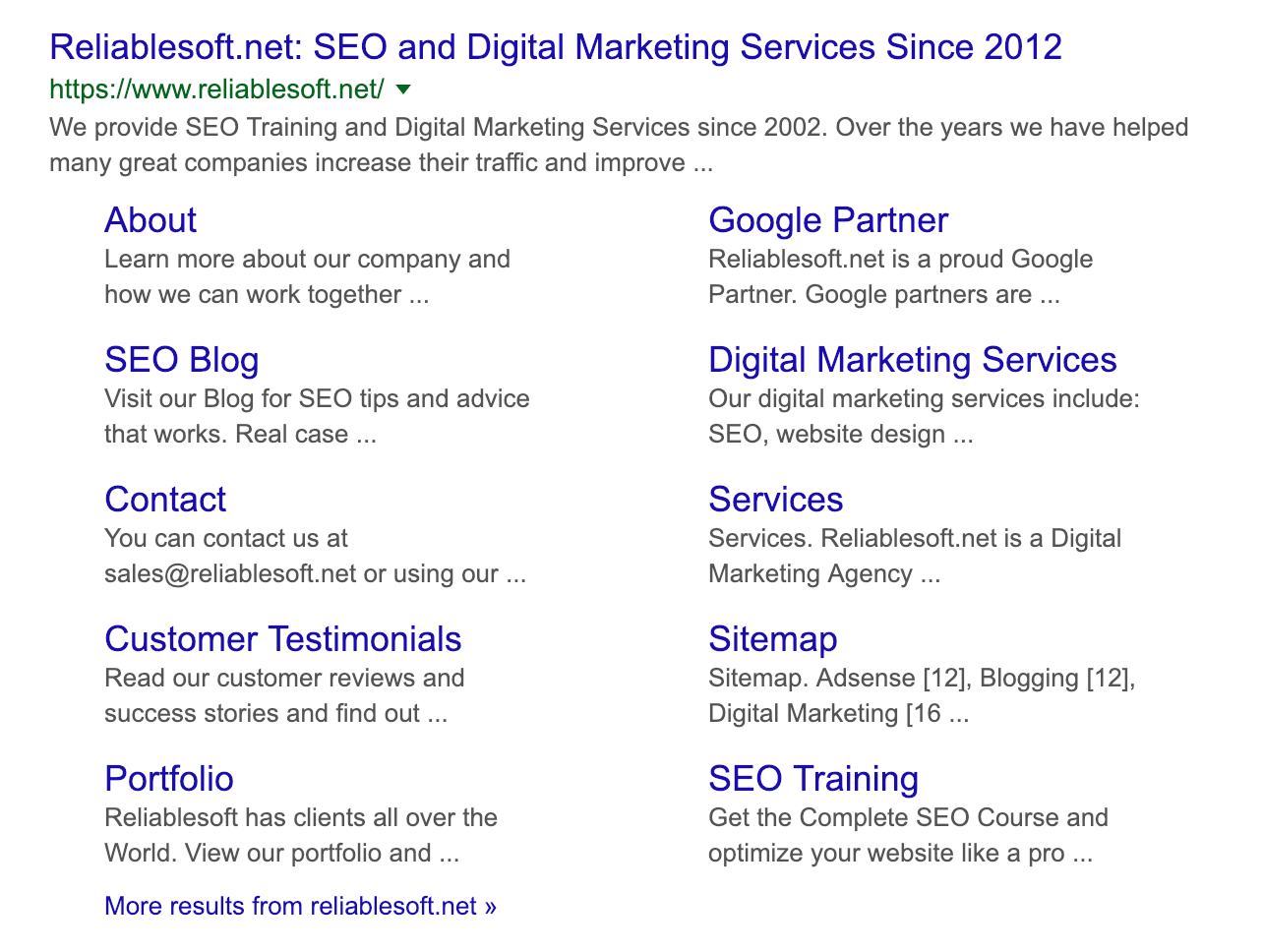
Another way to improve the appearance of your website on Google is through sitelinks.
Although you cannot directly control which sitelinks are shown for your website, there are ways to guide Google to pick the sitelinks you want.
29. Optimize your posts for Google sitelinks
Google shows sitelinks for individual posts too. Post sitelinks make your search snippet more attractive to clicks.
For example, look at the post sitelinks for one of my posts.
To help Google show sitelinks for your posts, you can ‘name’ the different sections of your article using the ID attribute or using named anchors.
Here is an example:

30. Optimize your posts for Google featured snippets using lists
Google loves to show lists on top of its search results. This is usually the case with the how-to type of articles, tips, or posts that include lists.
For example, try searching Google for “SEO Tips”, “Technical SEO checklist”, “How to become an SEO Expert” and you’ll see something like this:
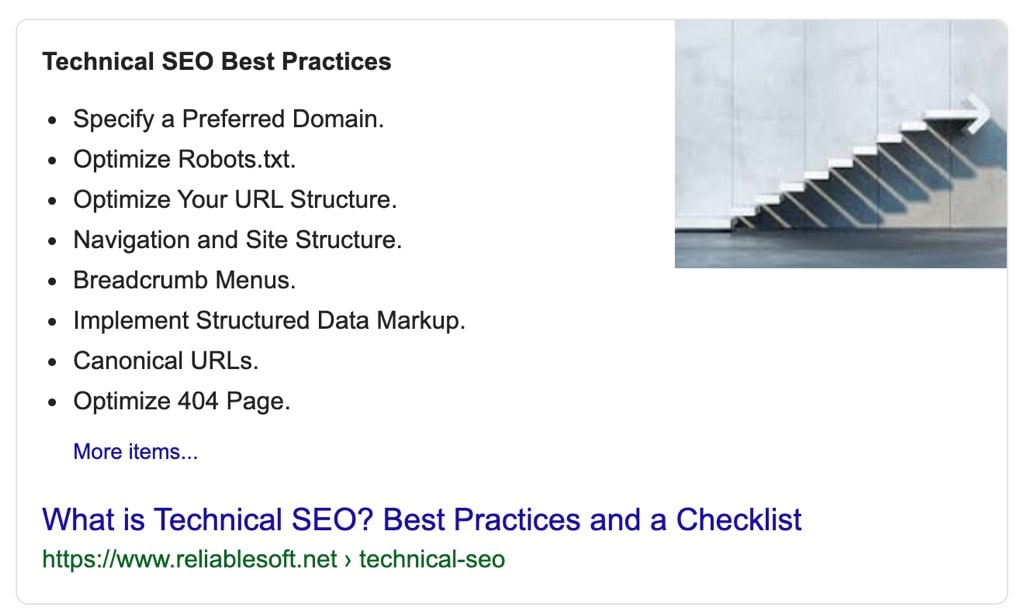
The good thing for SEOs is that it’s easy to configure your posts to be eligible for list snippets.
31. Check and optimize the H1 tag for all pages (including the homepage)
One of the on-page SEO elements that are easy to optimize is the H1 Tag.
The H1 tag is the first important element shown on a page and it usually has the same value as the page title.
H1 Tag SEO is easy:
- The H1 tag should be the same or slightly different than the page title
- Make sure that your H1 tag is visible and not hidden from users
- Style your H1 tag differently than the rest of the headings
- Use only one h1 tag per page
32. Check and optimize your page headings
Besides the H1 tag, you also need to optimize the other headings of your post. That’s usually the H2 and H3 headings.
SEO guidelines to follow:
- Don’t use heading tags when other tags such as bold or italic are more appropriate.
- Don’t overdo it with the use of headings. Use headings when it matters for structure, navigation purposes and to make the page content easier to read.
- You don’t have to use all heading types on a page. You can have the h1 and only h2s, depending on the length and type of your content.
- Having a balance between the use of headings and other formatting elements is always the best approach.
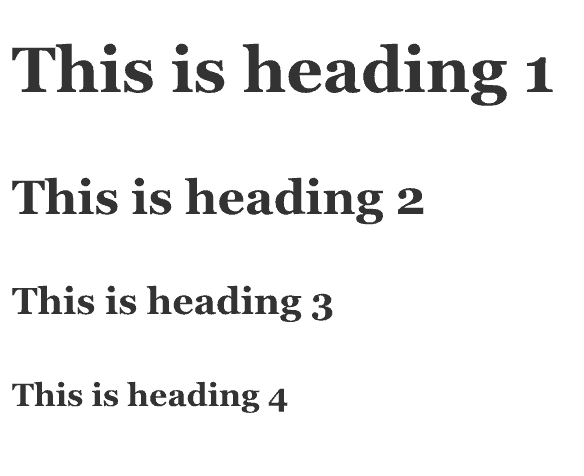
Look at the post you’re reading now as an example.
- I use H1 for the Title
- H2 for the main headings (On-Page SEO checklist, Technical SEO checklist, etc.)
- H3 for the individual items
33. Make sure that your target keyword is included in your opening paragraph
This is one of the basic principles of SEO content. Having the keywords, you want a page to be known for on Google in your opening paragraph makes your page more relevant for those keywords, for both search engines and users.
You don’t have to overdo it, mentioning your target keyword once or twice is enough.
Look at the example below:
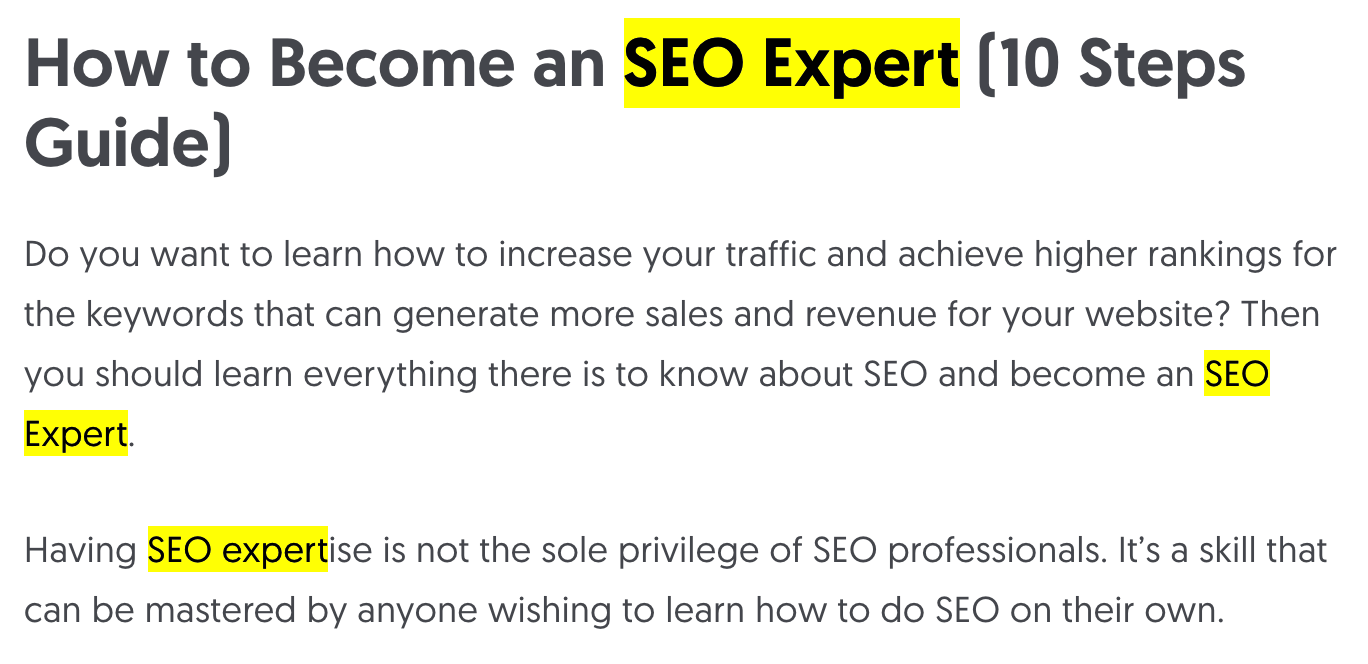
34. Add text content to accompany your non-text content
Search engines can better understand text than any other element so to make their job easier make sure that you always have text content on a page.
Having a page full of images or videos is not a good SEO practice.
35. Optimize your content for E-A-T
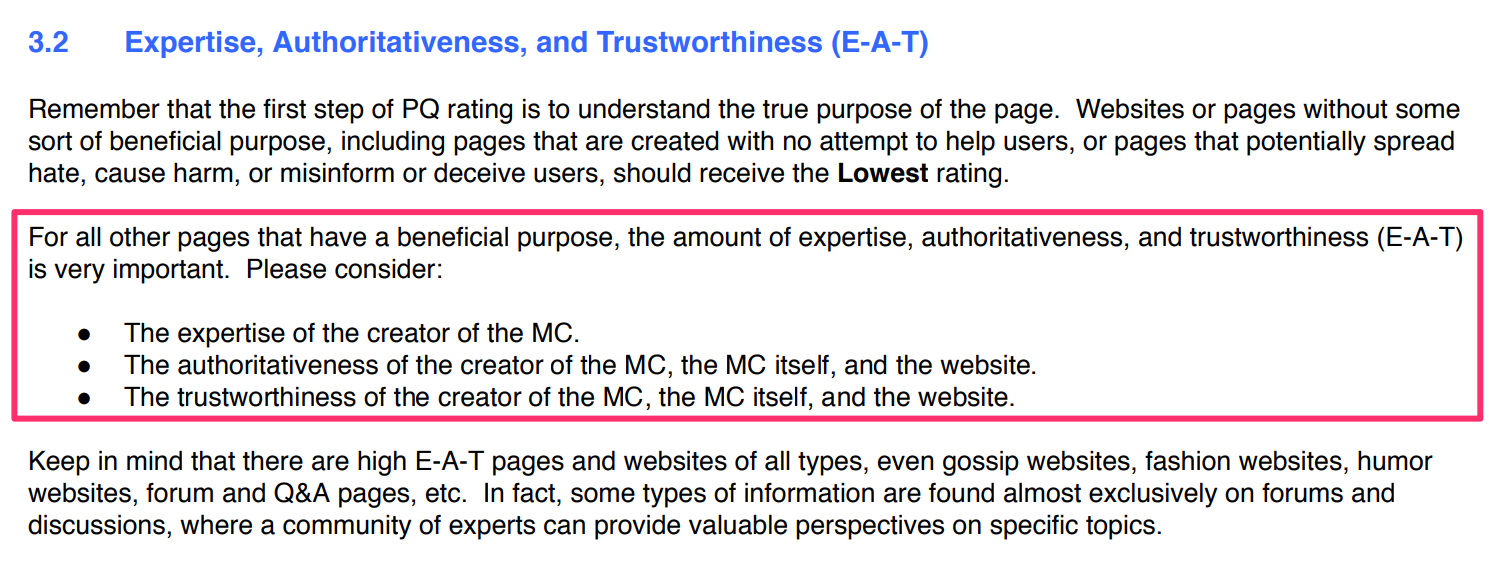
E-A-T stands for Expertise, Authoritativeness, and Trustworthiness. How is this related to SEO?
Google has recently introduced this concept to stress the fact that websites that rank high in their search results need to have a good reputation.
In simple terms, this means that Google is trying to rank websites that are proven to have authority and expertise about a topic and websites that are trusted by users.
36. Beautify your content (formatting and styling) and make it easy to read
Throwing text and images on a page it’s not the way to design a page that is to be eligible for ranking on Google.
You need to work on your formatting and styling and give users a nice experience. You don’t have to do something too fancy, just ensure that your pages are easy to read on all devices.
Don’t use fonts that are too small to read and make use of the available formatting elements to beautify your text.
37. Optimize your images
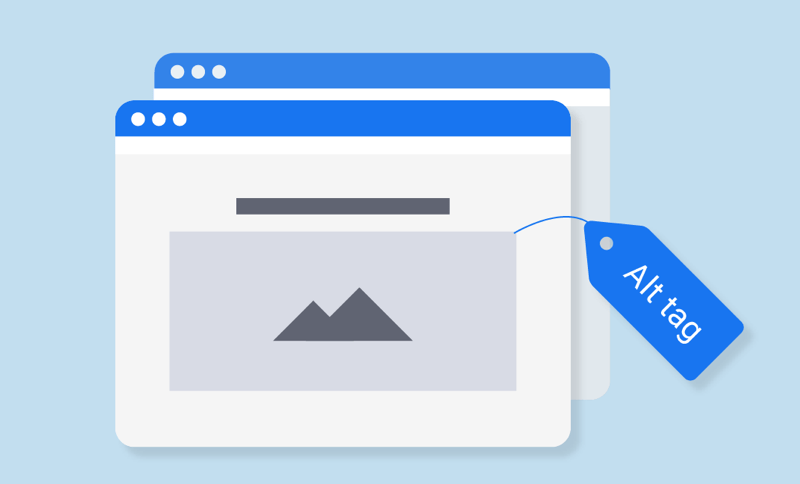
Image optimization is a must. Search engines are getting better at understanding what an image is about but for image SEO purposes you need to take care of three things:
Optimize the Image Filename
Image Filenames should be informative and accurately describe the image.
Optimize the Image file size
As a general rule of thumb the smaller the image size is (in bytes) the better.
- Don’t use dashes in your alt text.
- Write normally and try to describe in a few words what the image is about.
- Use keywords that are relevant to the content of the page but don’t overdo it.
- Keep your alt text short and to the point
38. Create a dedicated image sitemap and submit it to Google
Besides creating an XML sitemap for your pages, you also need to submit your images to Google.
You can add the images in your main XML sitemap or create a dedicated image sitemap like the example below.
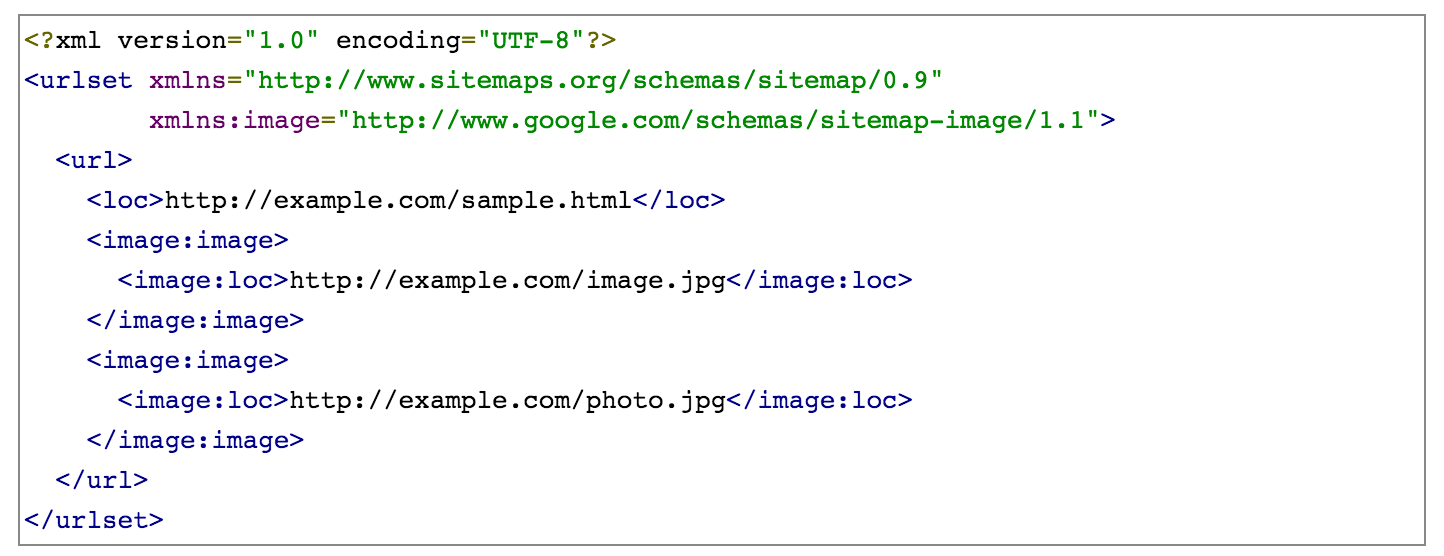
Don’t forget to submit your sitemap using the Google search console.
39. Optimize your videos and other multimedia elements (with proper schemas)
When you add a video to your content, either from YouTube, Vimeo, or by uploading it to your website, you also need to add the proper schema to help Google understand what the video is about.
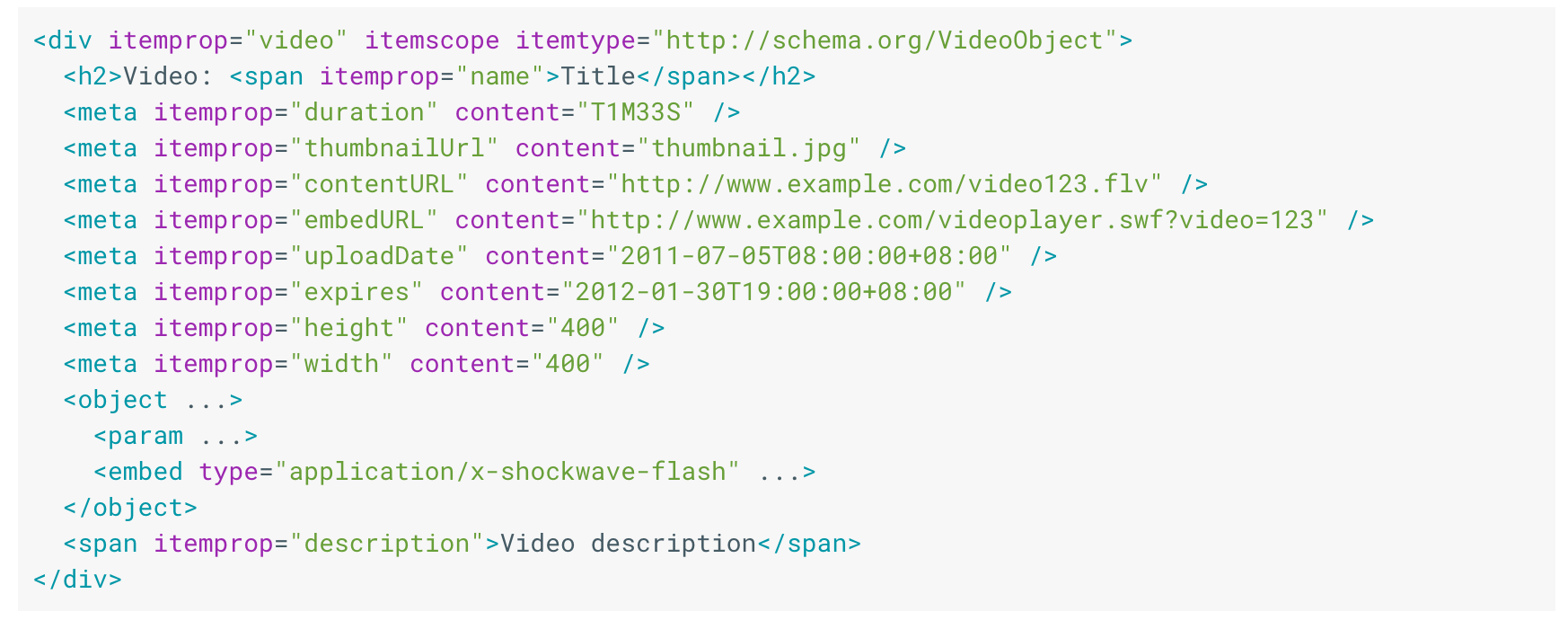
In the video schema, you can define the title, description, and thumbnail of a video.
40. Create a dedicated Video sitemap and submit it to Google
Just like images, if you use videos in your content, you also need to add them to a sitemap (either to your main sitemap or separate) and submit to Google and Bing via webmaster tools.
41. Optimize titles/description/content of your category pages
I see this all the time. Webmasters spend all their time optimizing their posts and product pages but forget about the category pages.
Category pages need to be treated the same way as ‘normal’ pages. This means optimizing their titles, descriptions, and content.
This is especially important if you have an eCommerce website.
42. Check your internal linking strategy
Internal linking is one of my favorite SEO tactics. The concept is simple, all you have to do is to interlink your website pages together, creating a small web.
Pages that have a greater number of internal links are considered by Google to be the most important pages of your site.
When adding internal links, make sure that you optimize your anchor text.
43. Give credit to other high-quality websites
This is actually SEO advice coming directly from Google and these are the exact words they used.
In simple terms, they are encouraging webmasters to link out to other high-quality websites on the Internet.
The reason is simple, it helps their algorithm in ranking the important websites on the top positions.
The SEO gains from doing so for your website are the following:
- You give your users a good option to learn more about a topic
- You position your content as a good source that links out to other good sources.
Keyword Research Checklist
Keyword research is a critical process for SEO. If you get your keyword research wrong, you’ll be targeting the wrong keywords.
This means that you may either fail to achieve high rankings because the keywords are too competitive or you may end up ranking for keywords that offer no real value to your business.
To make sure that none of the above will happen, follow the best practices in the keyword research checklist.
44. Understand what are SEO Keywords
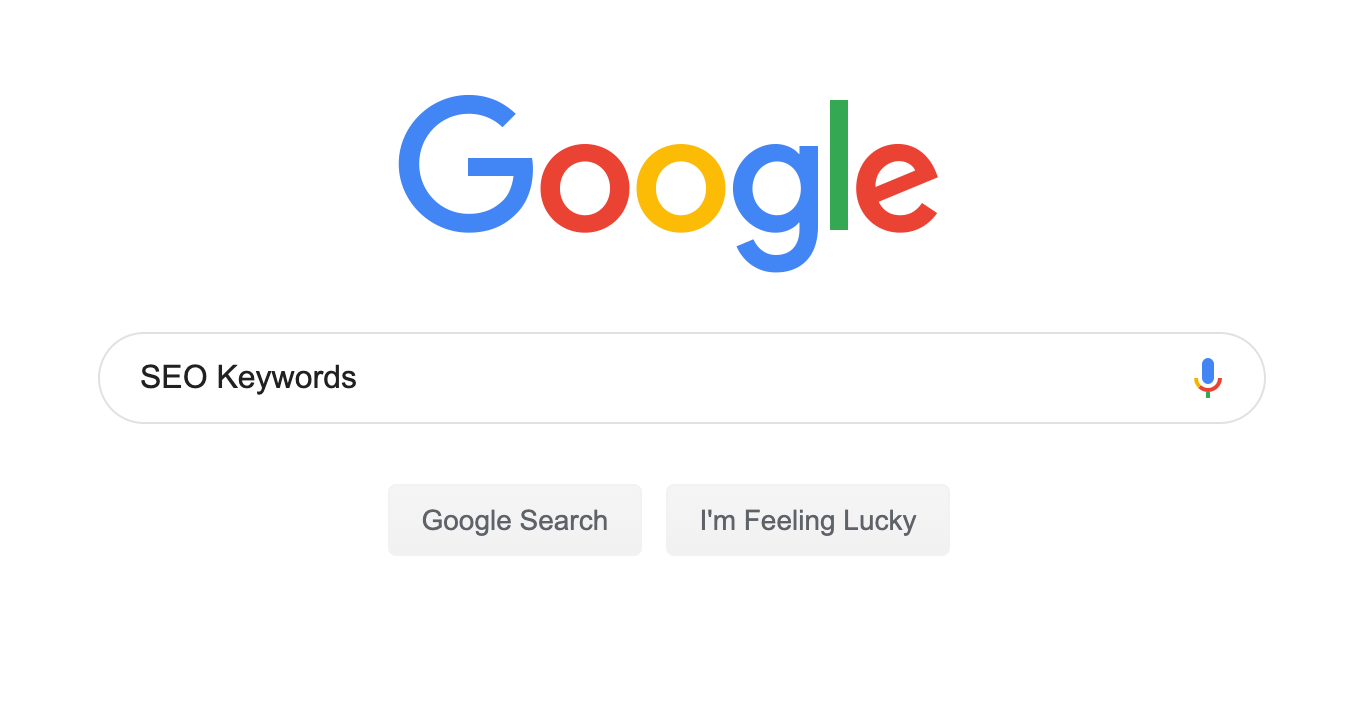
The first step before getting your hands dirty and starting doing keyword research is to understand what are SEO keywords and how to find the RIGHT keywords for your website or business.
This is a recommended step, even if you are an SEO specialist. I’ve been doing SEO for more than 15 years now and I see people all the time failing with SEO because they don’t understand the basics when it comes to keyword research.
45. Understand what are long-tail keywords
Long-tail keywords make up 70% of all searches and this means that if you don’t know what long-tail keywords are and how to target them correctly, you are minimizing your chances of getting any decent amount of traffic from search engines.
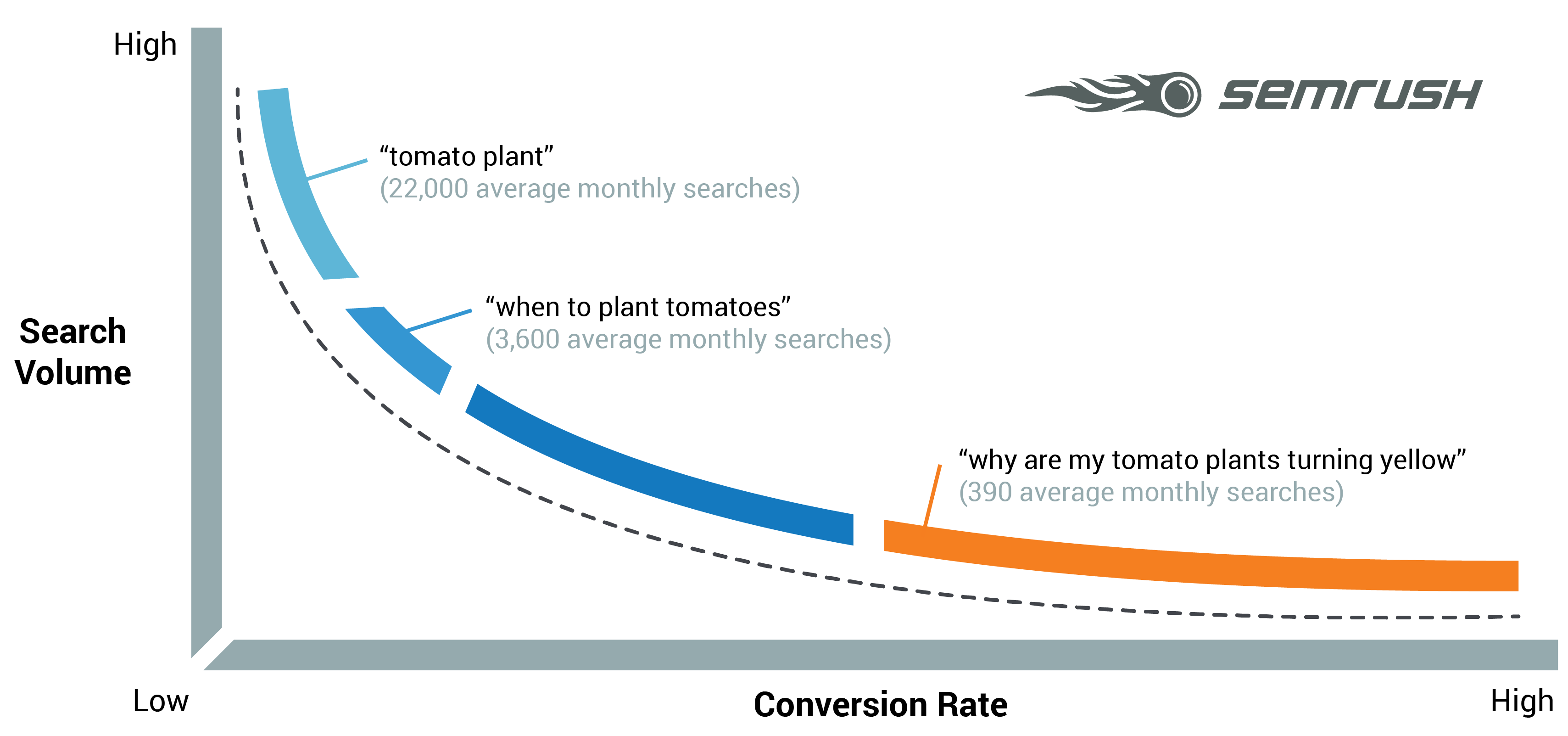
So, before proceeding to the next step, make sure that you know exactly the SEO strategy to follow to get to long-tail keywords.
46. Learn how to perform keyword research
Once you know the keyword research basics and have a clear idea in your mind of what you want to achieve with keyword research, it’s time to get your hands dirty and do it.
Your ultimate goal is to come up with a keyword list you can use to optimize your existing pages but also keywords to target with new content.
This combination is what will guarantee long-term SEO success.
47. Learn how to use the outcome of keyword research to optimize your content
To take advantage of your keyword research efforts, you need to know how the outcome of keyword research to optimize your content.
Follow these simple rules:
- Use your target keyword in the page title
- Use your target keyword in the page URL
- Use your target keyword in the H1 tag
- Use Long-tail keywords in your H2 and H3 headings
- Use related keywords in the image ALT Text
- Use related keywords and synonyms in your copy
- Use LSI keywords in your content
Off-Page SEO Checklist
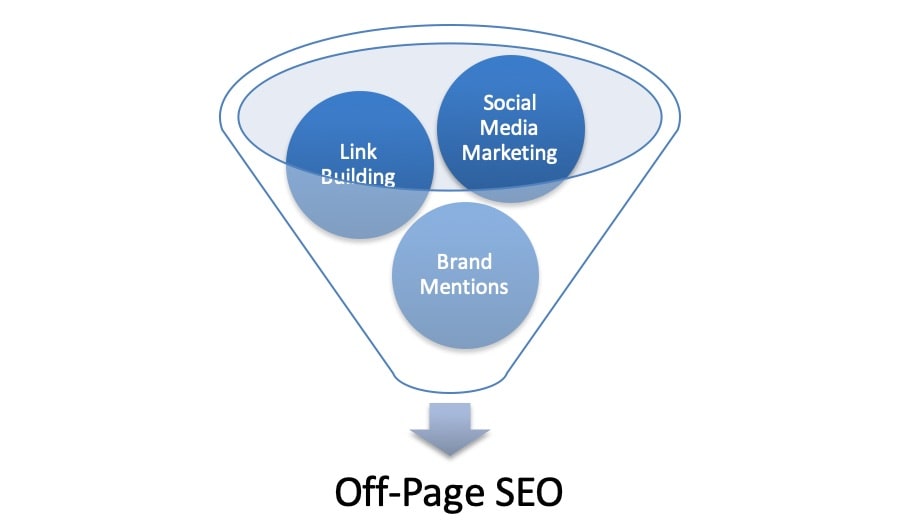
No SEO checklist is complete without mentioning Off-Page SEO.
Technical SEO and On-Page SEO (including content SEO), will help you create an SEO-friendly website that users will enjoy but to rank higher in Google, you need more than that.
This is where off-page SEO comes to the rescue. In simple terms, off-page SEO is about website promotion techniques and how to convince search engine algorithms that your website deserves a higher ranking in the search results than other websites.
Higher rankings will lead to more organic traffic and this is what all website owners want. Off-Page SEO is not optional but a necessary component of your SEO strategy.
Your overall goal with off-page SEO is to get high-quality incoming links from other related websites on the Internet.
Links act as a ‘vote of trust’ and they are taken into account by search engine algorithms.
Make no mistake, it’s not a numbers game i.e. it’s not about having more links than your competitors but it’s about having the right type of links that can push your rankings up.
Mistakes with off-page SEO i.e. buying links, participating in link exchanges, or other actions that violate Google webmaster guidelines, can get you in trouble.
A Google penalty (either manual or algorithmic) may be imposed on your website and you will lose your rankings and traffic.
Here is your off-page SEO checklist:
48. Learn what is link building and why it’s important
To succeed with off-page SEO, you first need to understand what is link building and why it’s important.
In simple words, links are important because they are part of the search engine ranking algorithms and can influence your ranking positions.
Websites with good quality incoming links are more likely to rank higher in the SERPS than websites with zero or fewer links.
This association of links and rankings was first introduced by Larry Page and Sergey Brin (Google Founders) when they wrote the initial Google ranking algorithm in the late 1990s.
Their idea was that websites that are referenced (linked) from other websites on the Web, are more important and thus deserve to rank higher in the search results.

Of course, things have changed a lot since then and a lot more factors are taken into account when calculating the ranking position of a page for a given keyword, but links still have a very important role to play.
It’s not only a number game i.e. the website with more links does not rank higher but it’s also a matter of where those links are coming from.
49. Learn the basic link building concepts
Besides understanding the importance of link building for rankings, you also need to familiarize yourself with basic link-building concepts.
You need to:
Understand the difference between a good link and a bad link
Not all links are equal. Good links can help your rankings, bad links can get you into trouble.
Understand the difference between white hat and black hat link building
There is a lot of talk in the SEO industry about white hat and black hat link-building techniques. You need to stay on the safe side and only follow white hat SEO practices.
Understand the difference between normal links and ‘nofollow’ links
Incoming links that carry the nofollow attribute do not count towards your rankings. They are still useful for branding and traffic purposes but they don’t help your rankings.
Natural links are the best links you can get
A natural link is what Google wants and knowing how to get it, can make a big difference to your rankings.
50. Get links from high authority websites
A critical item in the off-page SEO checklist is how to get links that can positively influence your rankings.
This is one of the most complicated and time-consuming processes of SEO but a very important one.
Read the guide below for all white hat link building techniques that are proven to work. I’m sure you’ll find some practices that you didn’t think about.
51. Review your link profile to identify and remove bad links
When working to build links to your website, sometimes things can get messy. You may end up having ‘bad links’ to your profile that can potentially get you into trouble.
It is thus recommended to review your link profile regularly and take action when needed.
Local SEO checklist
In addition to the above techniques, there is a subset of SEO called Local SEO.
Local SEO is the process of optimizing your website so that it appears in the first positions of Google, Bing, and Yahoo for searches that are related to your area/city/ country.
Everything included in this SEO checklist is beneficial for Local SEO, but when it comes to optimizing your website for searches related to specific locations, there a few more optimizations to take into account.
Your overall goal with local SEO is to rank higher for location-aware search queries like ‘Italian restaurants near me’ or ‘dentists in Pennsylvania’ or ‘wedding photographers in Montreal’.
Here is your Local SEO checklist:
52. Optimize your logo for local SEO
This is not the most important local SEO factor but every little bit helps.
Use your logo ALT text to give more details about the location of your business.
For example, if you have a business located in Florida, you can use this (see below) as the alt text of your logo.
<img src=”http://example.com/images/mayers-dental-surgeons-logo.png” alt="Mayers Dental Surgeons, Tampa, FL">
53. Add NAP information (Name, Address, Phone Number) on ALL your pages
Any signals you can give to Google related to your locality are useful for Local SEO.
On all your website pages, make sure that your full address details (street number, postcode, state, country, telephone number, fax number, email) are visible as text (not image) in a prominent position.
See below a few examples of good and bad NAP formats.
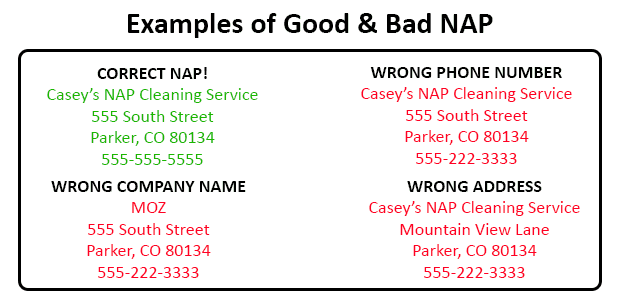
54. Make sure that NAP information is consistent across all channels
It is important to use the same information and format when displaying your name, address, and phone number on different channels across the web. For example on your website, Google My Business page, Yelp, Facebook, etc.
55. Add a Google map to the contact information page

On the contact us page make sure that you embed a Google map and have text content that shows your business name, address, and telephone.
56. Register your company with Google My Business
This is extremely important if you want your business to show up in the Google maps snippet (in the search results) and in Google maps.
Follow these steps to get started with Google My Business.
57. Use Schema to give more information about your local business to Google
Depending on the type of local business, you should use the appropriate schema.
You can read more information about local business schemas from Google and also from schema.org.
Here is an example of how the schema looks for a local restaurant. This piece of JSON-LD code should be added to the homepage.
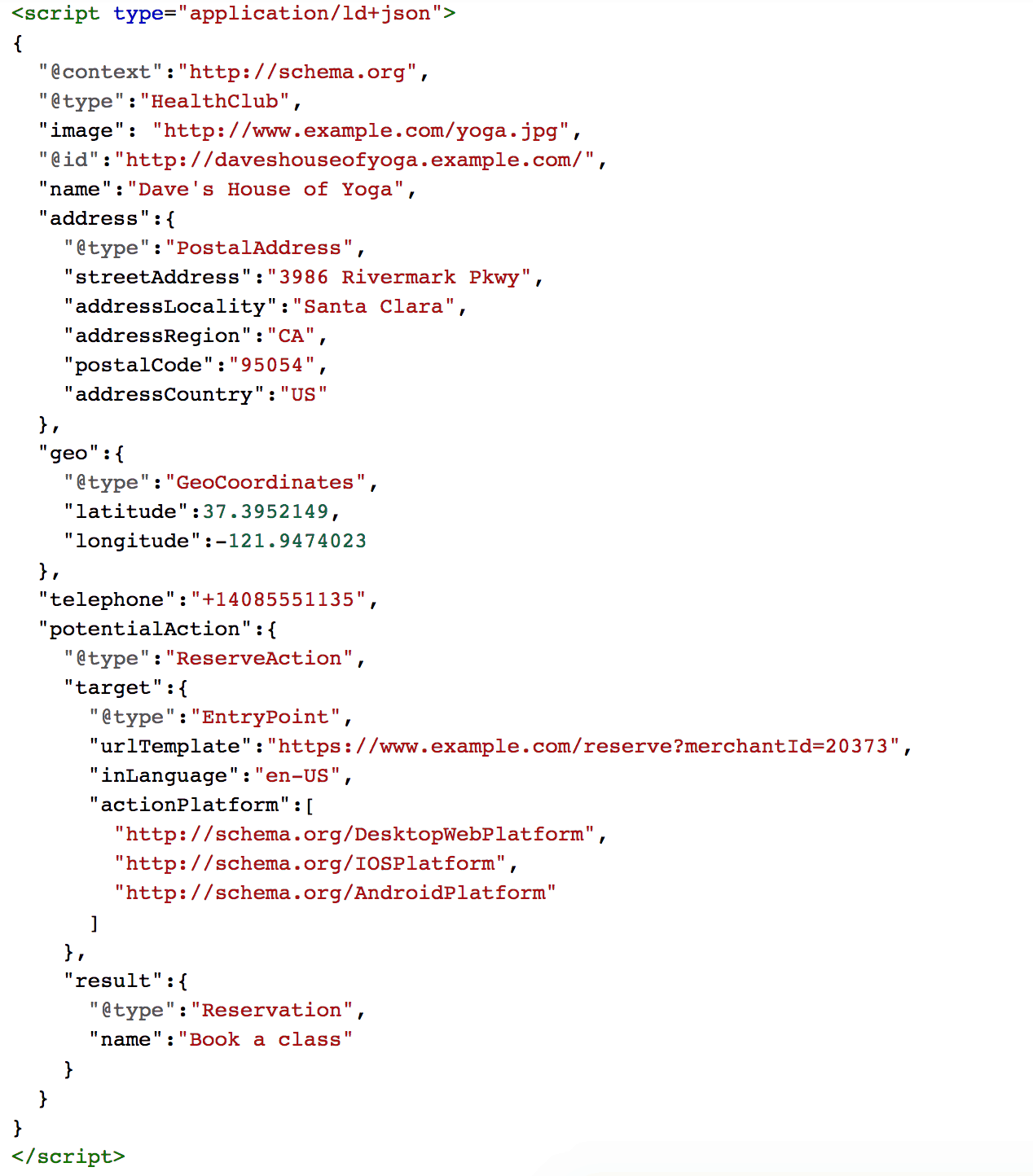
58. Register your website with relevant directories
Besides adding your website to Google My business, there are a number of other trusted directories you can use to list your website and give Google signals about your location.
Directories you can use:
- Register your website with Bing Places for Business
- Register Your Business with Local directories
- Create a Local business page on Facebook
- Register your business with Yelp for Business Owners
- Register with Foursquare for Business
59. Encourage and reply to every single review on all platforms
Authentic reviews can play a critical role in your local SEO rankings.
You need to encourage users to review your business on different platforms (Google my business being one of the most important) and it is equally important to reply to all reviews (either good or bad) on ALL platforms.
You can ask your customers to leave a review on their favorite platform either by giving them incentives i.e. 5% on their next purchase or by sending them reminders by SMS or email.
60. Seek mentions (links) from the local press
Any mentions (backlinks) you can get from trusted websites in the same city as your business, is a strong signal for your Local SEO.
For example, you can get a link from a local (online) newspaper or a magazine related to your niche.
Mobile SEO checklist
If you haven’t done this already, go and check your Google Analytics statistics and in particular the Devices Report (that’s under Audience / Mobile).
Most probably you will notice that at least 60% of your traffic comes from mobile. The rise in mobile searches has been huge for the last couple of years and it is expected to grow even more in the coming years.
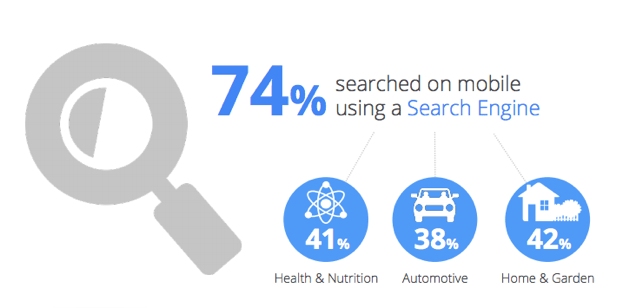
This factor led Google to create a mobile-first index. In short with the introduction of the ‘mobile-first-index’, Google will use the mobile version of a website for ranking purposes.
This means that if your website is not optimized for mobile, your rankings will eventually decrease and this means a great loss of traffic.
While going through the mobile SEO checklist, have in mind that your mobile website should include all the content found on your desktop site.
This includes having optimized titles, descriptions, text content, images, video, internal links, and everything that you show in the desktop version.
If you have a responsive website then you already made a big first step but mobile SEO is not just about having a responsive design.
Here is your Mobile SEO checklist:
61. Run the Google mobile-friendly test
The Google mobile-friendly test is a free tool by Google that will check your website and give you recommendations on how to make it mobile-friendly.
It’s a test that will check for basic mobile usability problems like small font sizes but it’s a good start.
62. Check your mobile speed using different tools
Loading speed is very important for users on mobile. Your goal is to make your website load on mobile in less than 3 seconds.
It’s not easy to do, you may need to use the help of a developer to get to that number but it is certainly worth’s it.
All the guidelines explained above for improving your page speed using lazy loading for images, optimizing your image file size will help a lot so if you haven’t already done this, add these items on top of your list.
Some tools to use to find out how long it takes for your website to load on mobile:
Don’t forget to also check the speed reports (under Enhancements) in the Google search console.
63. Test your mobile website on different resolutions
Besides checking your mobile speed, it is equally important to test how your website looks on different resolutions.
You need to ensure that the text is big enough to be read on mobile devices, that there are no horizontal scroll bars and that buttons are easy to click.
The best tool to use for this task is the Google Chrome Developer Tools.
64. Check popup usage on mobile
Google punishes mobile websites that make extensive use of popups and banner ads.
As a first step make sure that you don’t use popups on mobile and that there is enough content in the user’s viewport before showing any ads.
65. Check that your CTA on mobile are visible and easy to access
Call to Action (CTA) buttons and messages are important for a website’s success. At the end of the day, you want to optimize your website so that it gets traffic that you can take advantage of.
Since most of your traffic is coming from mobile, you need to check that mobile users can see your CTA buttons and messages and that they can easily access them.
This means that you may have to adjust your mobile design to position your CTA in places where they can be seen, like making use of sticky footers. (access my website on mobile to see this in action).
Conclusion
Having a checklist is a great way to work on your SEO. What you read in our SEO checklist above covers almost all areas of SEO.
If you manage to make your website compliant with all the above items, then you can feel confident that your website is in good SEO shape and this will eventually translate to higher rankings and more traffic.
A great way to learn everything you need to know to implement all SEO practices is to enroll in an SEO certification course. A good course will help you master SEO faster than any other method.
Final Advice
As mentioned in the introduction, don’t skip any of the items even if you feel that they are not very important.
Experienced SEOs know two things about search engine optimization.
The first is that a lot of small optimization changes can bring big results.
Second, besides knowledge another SEO success factor is patience. It takes time for SEO to work and you need to take that into account.
Don’t rush to a conclusion too soon, work through the list items one by one and be patient, results will follow.
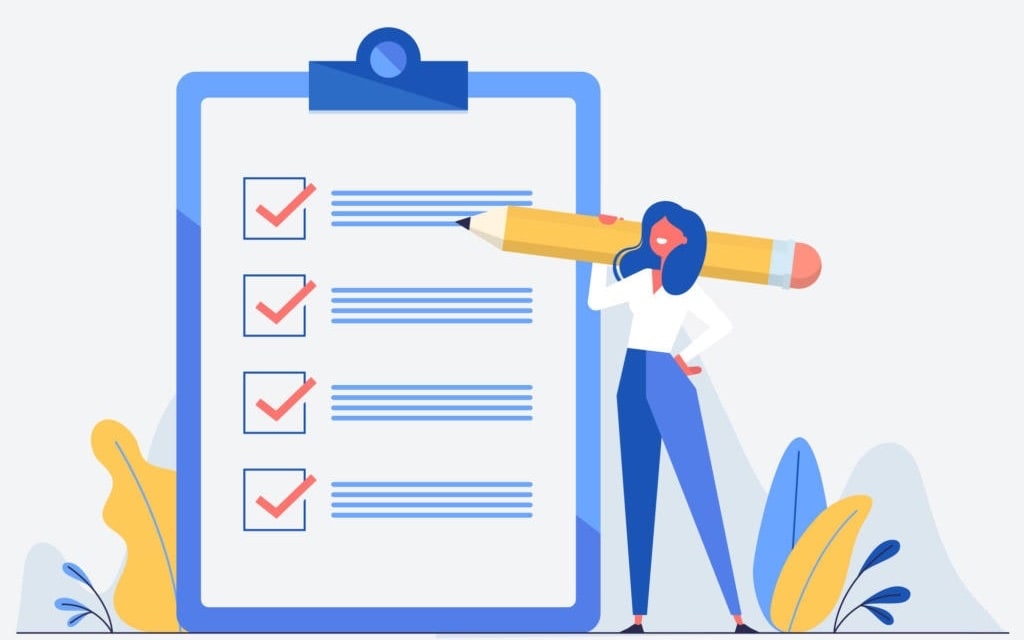




Comprehensive checklist it is. You did not leave any room to discuss more about SEO, by the way thanks for this huge informative post and i have also downloaded its PDF version.
Thanks Noman, glad you found our SEO checklist helpful.
All the best
Alex
Extensive and updated SEO checklist. Thanks a lot.
Hi Arsalan
Glad you liked it, thanks for your comment too.
Alex
Wonderful post Alex and your checklist is amazing and very useful.
Hi Faraz
Thanks a lot for your comment. All the best with your SEO efforts!
Alex
Website load time makes a huge difference in your ranking, so always make sure your website loads under 2 second.
Regards.
Hi Zamir
That’s right, website loading time is an SEO factor but also a usability factor. Less than 2 seconds is a great time to target.
All the best
Alex
As new to blogging I learned a new and amazing knowledge from this post. Keep sharing such amazing stuff.
Hi Prakash
Thanks a lot. Use the checklist as your guide to learn SEO.
All the best
Alex
Fantastic job Alex! Two thumbs up! I will definitely use this checklist for my SEO tasks.
Hi Mary
Thanks a lot! Don’t forget that you can download the checklist in PDF and print it.
All the best with your SEO
Alex
Thanks for the article Alex, it will help me work on my blog “trendy Lifestyle”.
Hi Tom
Thank you as well. All the best with your blog.
Alex
Thnx alex for sharing such an extra informative. You cover almost evry tips that a blogger should know
These tips helps me a lot to do technical SEO for my blog “freakyfact”.
I’ve discovered your site and blog recently and it’s a real eye opener. SEO is much more than I thought it was and with your checklist, I’ll be able to sort between the items I can do and those I’ll need help extra on. Thanks.
Hi Irene
Sounds like a good plan.
Thanks for passing by 🙂
Alex
Comprehensive and very updated SEO checklist! I will go through the checklist one by one and see if I missed something. Keep posting!
Hi Jim
Thanks a lot. Yes, the list is updated regularly to cover all latest SEO practices.
All the best
Alex
So detailed content man everything at one place, nice work keep it up
Thanks for the list, It will help to improve SEO
Hi Alex,
Very informative list.
I have problems with my site speed i will read your post on SEO tips for beginners.
Hi Alex, thank you for the valuable insight into SEO, and the checklist is a huge help for us SEOs!
Thanks again from Team Altair!
This was really helpful to me, thank you! I was just looking for seo checklist like this, as I’m currently working on a new site.
This is so good, Thank you for taking the time to think through all these points and remind us.
The list and information are very detailed. I have to say I felt afraid of the big number at first, but they are reasonably essential. Thank you for collecting them and sharing the post.
Thanks Aiden. Glad you liked it.
All the best
Alex
Fantastic job Alex! Two thumbs up! I will definitely use this checklist for my SEO tasks. Keep it up.
Great post thanks for sharing this valuable information with us all. The infographics only add values to you post as well. Your extensive research will definitely help a lot of people in their SEO process. Nice work and thanks for providing the downloads as well.
Glad that you shared this comprehensive article with us. I have read the complete blog and will make sure to meet these checkpoints before uploading my next article. Thanks for sharing.
Amazing content Alex you explained it very well. Keep up good work
WOW amazing list, I will now try to check my own blog based on all points. I’m impressed :))
Thanks for sharing this seo checklist.
WOW. What a wonderful job you did, this list is so extensive. Thank you for sharing!
Hi Blanca
Thanks a lot! Glad I could found my checklist useful.
All the best
Alex
The tips you shared for getting quick wins for link building are very simple and easy to understand. I will use this article as my reference frequently since I will need to put into practice each point mentioned.
Hi Steven
To fully SEO optimize a website takes time and effort. I’ll do my best to keep this SEO checklist updated to cover all the important SEO tasks you need to perform.
All the best
Alex
Thanks for sharing this seo checklist.
Hi Krishan
Thank you as well.
Alex
Great post, thanks for sharing the comprehensive article with SEO Checklist. This is very useful and i am sure it will benefit and help to improve SEO projects. Thanks again.
Hi Ramesh
Thanks for your comment. All the best with your SEO efforts.
Alex
Great article on SEO!, All the points that you’ve covered has an impactful significance on the SEO score of a website. I found this helpful. Thanks for sharing such an amazing piece of content.
Hi Aditya
Thanks a lot for your comment. I’m glad that my SEO checklist helped you improve your website’s SEO score.
All the best
Alex
Hello, I read your blog on the SEO Checklist. Thank you so much for this post. Keep it up and write more post like this.
Really comprehensive list – nice 1!
Hi Brinley
Thanks for commenting. I’m glad that you found our SEO checklist useful.
All the best
Alex